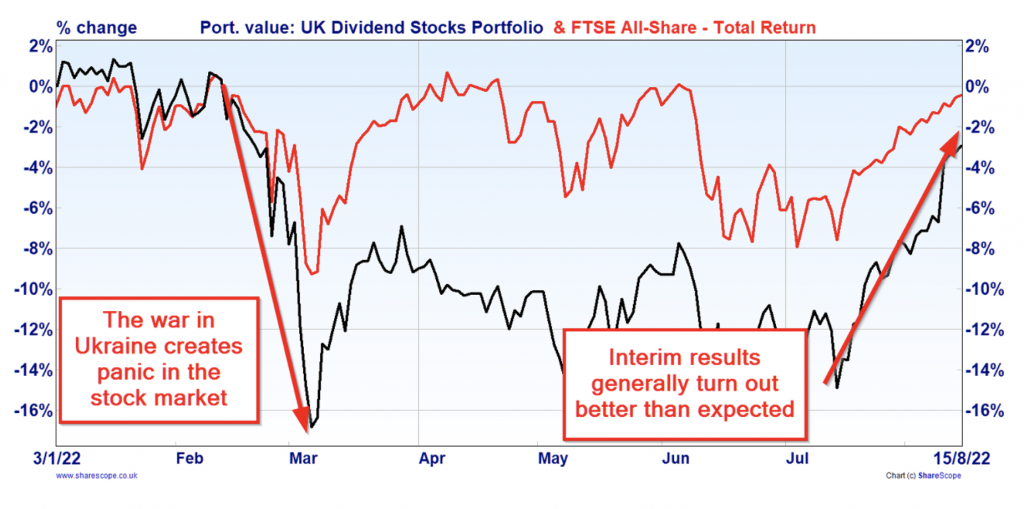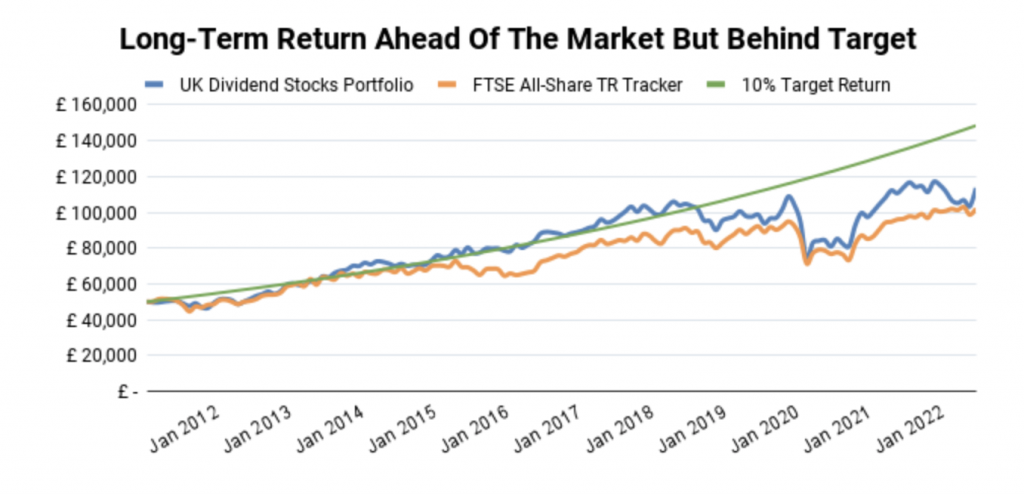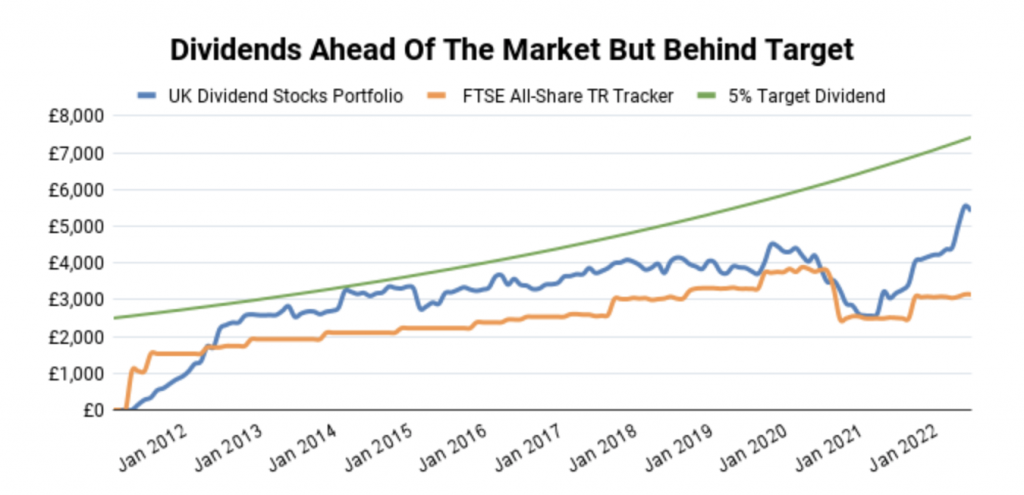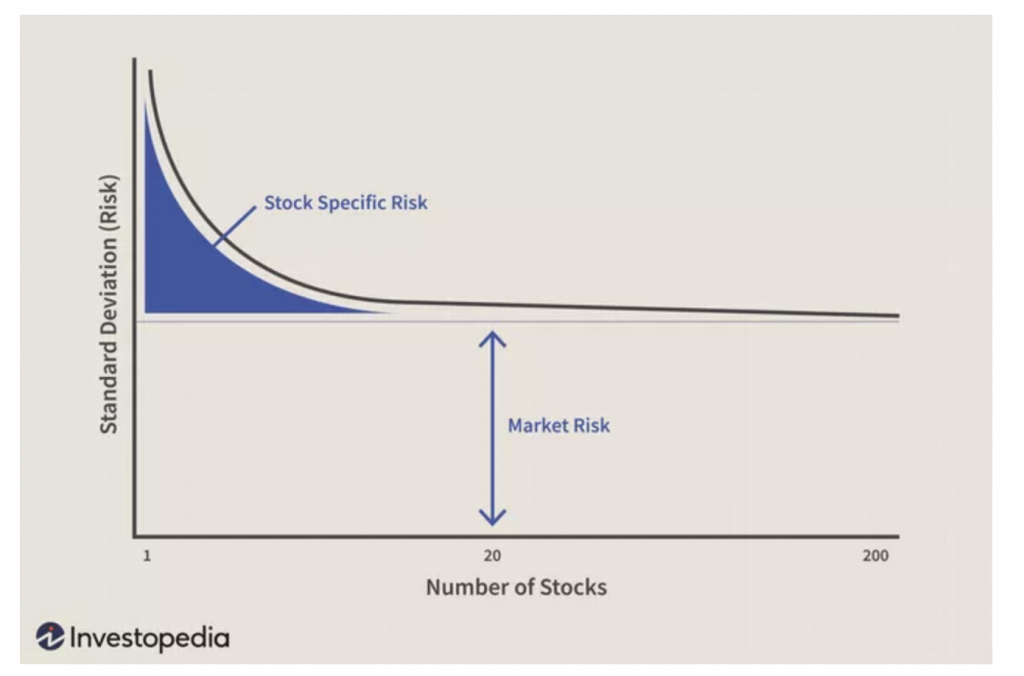Welcome to a slightly delayed 2022 half-year review of the UK Dividend Stocks Portfolio.

My original plan was to review the portfolio in July, but work (mostly a slew of interim results that needed analysing) got in the way, so here we are with a mid-year review in mid-August.
As usual, I’ll review the portfolio’s performance as well as any changes I’ve made to the portfolio or my investment process, and I’ll highlight any key points you may find useful.
Markets fell in early 2022, but over the long-term they tend to go up
The beginning of 2022 was of course marred by Russia’s invasion of Ukraine. The long-term consequences of that invasion were (and still are) highly uncertain, so many investors sold up and headed for safer ground. As a result, share prices and stock markets fell off a cliff.
At one point the portfolio was down 16%, which isn’t quite bear market territory, but it’s enough to make me feel slightly uncomfortable. And that’s an interesting point, because I know, intellectually, that short-term performance is irrelevant, but this sort of decline still has a (small) emotional impact on me.
So, here are a couple of mental tricks I use to help me ignore short-term price volatility:
- Rule of thumb: measure progress using dividends rather than share prices.
- Rule of thumb: if you do look at capital gains or losses, ignore one-year returns and focus on returns over five years and 10 years.
I’ll get to the portfolio’s dividends in a minute, but first, let’s focus on longer-term capital gains so we can put these short-term ups and downs in context. Also, the portfolio only invests in FTSE All-Share stocks, so that’s the benchmark.
If we focus on the very short term by looking at returns from the start of 2022 to early March, when markets hit rock bottom, the portfolio was down 16% and the FTSE All-Share (total return) was down about 9%. This is the sort of thing that makes investors jump ship long before they’ve reached their investment goals.
if we zoom out and focus on five-year total returns then things look a little less bleak, with the portfolio producing total returns of 19% versus 23% for the All-Share, or 3.6% and 4.2% per year on an annualised basis. That isn’t great, but it isn’t surprising either, given that we’ve just been through a global pandemic and we’re on the brink of a UK recession. More importantly, returns over five years are positive.
If we zoom out even further, total returns over 10 years are 121% for the portfolio and 102% for the All-Share, which is 8.2% and 7.3% annualised, respectively.
I don’t know about you, but this helps me put short-term declines into context. Yes, markets fell quite a bit in early 2022, but over 10 years or more they tend to go up, and they tend to go up quite a lot.
Here’s what those longer-term returns look like on a chart.

From this 20,000 foot perspective, the recent market declines look like nothing more than just another temporary (and inevitable) setback in a long-term uptrend.
In fact, markets have recovered in recent weeks and, as I write, the portfolio is down just 3% for the year, while the All-Share is up 1%. Investors who jumped into cash in March may well be kicking themselves.
As you no doubt spotted, the chart above includes a 10% Target Return line. This shows you where the portfolio would be if it was performing in line with my target return of 10% per year. Of course, no equity portfolio is going to metronomically produce 10% returns per year, but I find it useful to plot out where I would like the portfolio to be (ideally, above that green line).
That 10% Target Return line ties in with my long-term goal for the portfolio, which I’ll explain in a moment. But first I want to cover some of the results statements that have come in over the last few weeks.
Despite the obvious headwinds, the portfolio’s interim results were surprisingly positive
Seventeen out of the portfolio’s 24 holdings have now announced their interim or annual results and just about every one of them was upbeat.
The only dividend cut came from Admiral Insurance, but that was expected because the 2021 dividend was abnormally high, thanks to lockdowns that massively reduced the number of miles driven (and therefore the number of claims).
Other than Admiral, dividends were either maintained or raised and most holdings have seen little or no sign of an economic slowdown. That stands in stark contrast to the fairly large share price declines that some of these companies have suffered, so here’s another useful mental trick:
- Rule of thumb: measure your portfolio’s progress by the financial results and dividends of its holdings, not by whether their share price went up or down.
Let’s turn back to my 10% total return target to see how it relates to my long-term investment goals.
The pandemic has been an unexpected obstacle, but my long-term investment goals are not yet out of sight
My long-term goal is to grow the portfolio from a starting value of £50,000 in 2011 to more than £1 million by 2041. And although it’s a virtual portfolio, I hold exactly the same stocks in my real-world portfolio (and nothing else except a very small amount of cash).
Going from £50,000 to £1 million in 30 years requires an annualised total return of around 10%, compared to a long-term annualised total return of about 7% for the UK stock market.
So, beating the FTSE All-Share is my bare-minimum goal, but I really would rather have that 10% total return, split approximately evenly between a 5% dividend yield and a 5% underlying dividend growth rate.
Ideally, the portfolio would have grown to £148,000 by now, but it’s some way behind that at £113,625, although it is ahead of the All-Share which is in third place at £102,090.
As the chart above shows, everything was going to plan from 2011 to 2018, with the portfolio closely tracking that 10% total return target. But then we had Brexit, a global slowdown in 2018 and of course the pandemic and the invasion of Ukraine, and all of these have all conspired to hold the portfolio back over the last five years.
I haven’t taken this lying down, so over the last few years I’ve worked hard to understand (a) what had gone wrong and (b) what I could do to fix it. In terms of what went wrong, here’s what I came up with:
- My stock selection process was not sufficiently thorough.
- I was investing in too many low-quality companies.
- I wasn’t investing enough into the portfolio’s most attractive holdings.
Since uncovering these methodological flaws, I’ve spent the last two years developing and refining fixes that I hope will bring the portfolio back to and ahead of its 10% annualised return target over the next two decades.
I’ll explain these fixes in a moment, but first I want to look at the impact they’ve had on the portfolio’s dividends, because as I said earlier, dividends are a much better measure of progress than share-price movements.
The portfolio’s dividends have dramatically improved over the last year
Although I said my goal is to grow the portfolio to £1 million by 2041, my primary goal is for the portfolio to produce an annual dividend income of at least £50,000 by 2041.
The £1 million goal is simply a consequence of that income goal. If the portfolio reaches £1 million by 2041 then it would produce that £50,000 income with a 5% dividend yield, so as I’ve already said, I also want the portfolio to have a dividend yield that is consistently above 5%.
With all that in mind, here’s a chart showing the portfolio’s rolling 12-month dividend versus its FTSE All-Share benchmark, as well as the Target Dividend the portfolio would be paying if it was on target to reach my long-term income goal.

The chart tells us that, in an ideal world (the green line), the portfolio would have paid dividends totalling £7,422 over the past year, on route to that £50,000 dividend in 2041.
The portfolio’s actual dividend came to £5,402, so it’s behind target, but this is still a dramatic improvement relative to the FTSE All-Share’s meagre income (£3,147) and the portfolio is now paying a dividend 72% larger than the All-Share’s.
As I mentioned earlier, this dramatic improvement in dividends has been driven by the changes I’ve made to my investment process over the last two years, so let’s dive in to some of those changes.
Higher dividends are the result of a much-improved investment process
I made three relatively large changes to my investment process and they were all introduced in late 2020 and early 2021. Remember that the goal was to improve the quality of my research, to improve the quality of the companies in the portfolio and to tilt the portfolio towards its best holdings, so the main changes were to:
1. Spend weeks rather than days analysing quality dividend stocks.
I made the decision to invest exclusively in quality dividend stocks because, historically, they had been my best performing investments.
Initially this involved ejecting anything from the portfolio that wasn’t high quality, but it also involved raising my standards for what constituted a quality company and raising the amount of time spent analysing a potential investment from several days to several weeks.
To see purchase and sale reviews for the lower-quality companies I sold through 2020 and 2021, have a look at the UK Dividend Stocks Portfolio page and scroll about halfway down.
- Rule of thumb: only invest in quality dividend stocks.
- Rule of thumb: spend up to several weeks analysing a potential investment rather than several days.
2. Estimate fair value using discounted dividend models.
In addition to focusing exclusively on quality dividend stocks, I also started estimating their Fair Value using discounted dividend models. This involves estimating the company’s future dividends and then calculating what a typical investor would pay to buy that future stream of dividends.
I also started calculating a Good Value price, which is the price where the expected annualised return from those future dividends meets my target of 10% per year. And last but not least, I started calculating a Margin of Safety, which tells you where the price sits between Good Value and Fair Value.
If you’d like to have a go at making a discounted dividend model for your favourite stock, while also estimating its Fair Value, Good Value and Margin of Safety, feel free to use my dividend stocks spreadsheet.
- Rule of thumb: only buy quality dividend stocks where there is a sufficient Margin of Safety between the current share price and Fair Value.
3. Combine concentration with diversification and rebalancing.
Historically, the portfolio held around 30 stocks because I thought that provided a reasonable balance between concentration (to improve returns by focusing on the most attractive stocks) and diversification (to reduce risk).
After my company analysis process became much more detailed and time consuming, I found that I simply didn’t have time to apply that level of research to 30 holdings. So, I started looking for a solution and came across two opposing but complimentary ideas.
The first idea came from Warren Buffett and the idea is to invest as much as you can stand into your most attractive investments. More specifically, I found the idea in an excellent book about Buffett’s early investment partnership called Warren Buffett’s Ground Rules.
“We presently have two situations in the over 25% [position size] category [and] it is worth pointing out that our performance in 1965 was overwhelmingly the product of five investment situations” – Warren Buffett, 1965
Like most good ideas, this one is simple. We know that each stock has a different expected risk and return profile, which means they can be ranked in order of attractiveness. If a particular stock has the best risk-return profile of any investment you know of, why would you put money into your second-best idea when you can put more into your best idea?
Of course, there are limits to this, otherwise you would end up investing 100% of your money into one company. If that company went bust you would lose everything, so diversification still has a place. However, for Buffett, the need for diversification does not override the need to invest as much as you can stand into your best opportunities.
In Buffett’s case, he was willing to put up to 40% of the Buffett Partnership into one company. In my case, I had a position size limit of 6%, which was about double the average position size given that the portfolio had 30 holdings.
I agreed with the logic of Buffett’s approach, so I thought about how much I could stand to have in my most attractive holding (the one with the best combination of quality, defensiveness and value).
This was my thought process:
- If I put 40% into one company and it goes bust, the remaining 60% of the portfolio will have to grow by 67% to offset that loss.
- My target rate of return is 10%, so that recovery would be expected to take 5-6 years.
- I didn’t want a single mistake to set the portfolio back by 5-6 years; I thought a one-year setback was more acceptable.
- On that basis, I decided to increase my maximum position size to 10%.
- Rule of thumb: don’t invest more into one company than the portfolio can recover from within one year.
The second of the two ideas I stumbled across came from Ray Dalio, founder of the world’s largest hedge fund. Dalio’s idea is based on the age-old principle of diversification and it’s sometimes known as Dalio’s Holy Grail strategy.
“While you can’t know which of the items you are betting on will provide better results, you do know that they will behave differently, and by mixing them appropriately you can reduce risk. Diversifying well is a matter of knowing how to reduce your expected risk by more than you reduce your expected return” – Ray Dalio, 2019
Dalio’s approach is basically the opposite of Buffett’s. Buffett says invest as much as you can stand into your best idea, then max-out your next best idea and so on.
Dalio says it’s very hard to know what the best idea is, so focus on investing in relatively uncorrelated assets, i.e. assets where one zigs while the other zags, and then periodically rebalance your assets back to your target allocation.
Rebalancing involves trimming oversized holdings and topping-up undersized holdings. This usually means selling holdings where the price has gone up in order to top-up holdings where the price has gone down. If you’re invested in large, stable, high-quality companies, this usually means you’re selling high and buying low, and that’s the fundamental principle of all sound investing.
“Most investors tend to think that investments that have produced good returns over the past few years are good investments rather than less good investments because they’re more expensive, so they inappropriately buy more near the tops and sell more near the bottoms. That is the biggest mistake in investing.
On the other hand, rebalancing (i.e., selling off enough of those positions that have done better than average and buying enough of those positions that have done worse than average in order to return the actual mix of assets to the targeted mix) will likely both raise returns and reduce risk.” – Ray Dalio, Diversifying Well Is the Most Important Thing
Despite their different approaches, Dalio is on more or less the same page as Buffett when it comes to the number of holdings required to optimise the balance between concentration and diversification.
“The magic is that you only need to do this simple thing. This simple thing is to find 15 or 20 good uncorrelated return streams” – Ray Dalio
Dalio’s target of 15 to 20 holdings is similar to the general finding that after about 20 holdings, adding more stocks doesn’t materially reduce risk.

So, in addition to upping the position size limit from 6% to 10%, I also reduced the target number of holdings from 30 to between 15 and 20. Currently the portfolio has 24 holdings and I’m hoping to get it down to 20 within the next year or so, mostly by selling off existing holdings as and when their share price moves close to fair value.
- Rule of thumb: Aim for 15 to 20 holdings as the sweet spot between concentration and diversification
Each of these changes has been designed to tilt the portfolio towards UK dividend stocks with the best combination of quality, defensiveness and value and, so far, they seem to be working according to plan.
Buying, selling, trimming and topping-up to improve the portfolio’s income and growth
As I’ve already mentioned, the number of holdings in the portfolio has fallen from 35 in 2020 to 24 today, and it will probably fall to 20 within a year or two.
The portfolio is also much more heavily focused on its most attractive holdings than it was before. Pre-2020, my largest position would typically be somewhere around 5%. Today, there are eight positions larger than 5% (the largest being 7.3%) and those eight positions make up 50% of the portfolio’s value.
Those eight holdings are (by design) also the most attractive. They have an average dividend yield of 6.5% and that’s why the portfolio’s dividend has more than doubled over the last year or so, giving the overall portfolio a dividend yield of 5%.
This improvement has been achieved with, on average, one trim, one top-up and one buy or sell trade (adding or removing one holding) each month. So although regular maintenance is required to keep the portfolio in tip-top shape, this amount of trading takes less than an hour once per month.
- Rule of thumb: make up to one trim, one top-up, one buy and one sell trade per month.
The short-term outlook is not good, but I’m optimistic over the medium-term and longer
Although the interim and annual results that came in from the portfolio’s holdings over the last few weeks were almost unfailingly positive, there are of course very dark clouds overhead.
We have the ongoing war in Ukraine, related record gas prices and shortages in Europe and extremely tight labour markets that make persistently high inflation more likely. On that basis, I fully expect the short-term to be unpleasant.
However, markets for goods and services tend to be self-correcting as high prices lay the seeds of lower prices through increased supply and reduced demand, and humans are nothing if not adaptable.
In addition, downturns are often a tailwind for quality companies because their stronger profitability allows them to continue investing in marketing while retaining more of their staff. This allows them to take customers and market share from their weaker peers, which then shows up as market-beating growth when the recovery arrives.
Given the extremely low valuations that some of these quality companies are currently trading at, I think they are well-positioned to produce very attractive returns over the next five or ten years and that, of course, is the sort of time-horizon long-term investors should be focused on.







